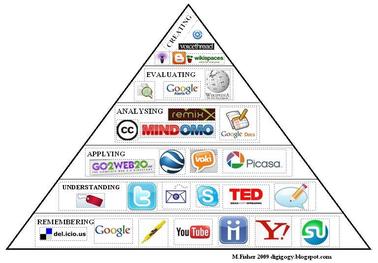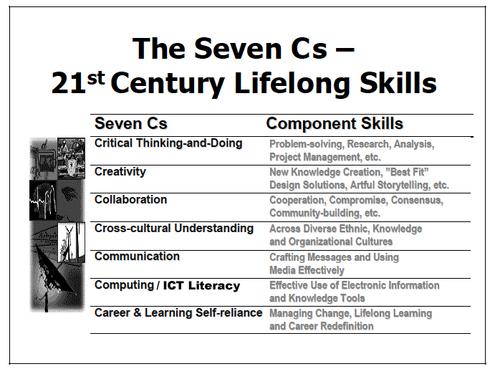21st Century Learning
What Do 21st Century Learners Need?
Bloom's Toxonomy, Constructivism and 21st Century Skills
Blooms Taxonomy has long been used to describe and organize thinking behaviours that are considered important to learning outcomes. Describing differing levels of complexity, Benjamin Bloom organized learning into six major categories, from the simplest behaviour to the most complex. At the more basic end of the spectrum is knowledge, with the most complex demonstration of learning being described as evaluation.
The 6 levels including sample outcome verbs are listed below:
- Knowledge (Recall data or information) e.g.: defines, describes, identifies, knows, labels, lists, matches, names, outlines, recalls, recognizes, reproduces, selects, states.
- Comprehension (Understand the meaning) e.g.: comprehends, converts, defends, distinguishes, estimates, explains, extends, generalizes, gives an example, infers, interprets, paraphrases, predicts, rewrites, summarizes, translates.
- Application (Use a concept in a new situation ) e.g.: applies, changes, computes, constructs, demonstrates, discovers, manipulates, modifies, operates, predicts, prepares, produces, relates, shows, solves, uses.
- Analysis (Separate material or concepts into component parts so that its organizational structure may be understood. Distinguishes between facts and inferences) e.g.:
- Synthesis (Put parts together to form a whole, with emphasis on creating a new meaning or structure) e.g.: categorizes, combines, compiles, composes, creates, devises, designs, explains, generates, modifies, organizes, plans, rearranges, reconstructs, relates, reorganizes, revises, rewrites, summarizes, tells, writes
- Evaluation (Make judgments about the value of ideas or materials. ) e.g.: appraises, compares, concludes, contrasts, criticizes, critiques, defends, describes, discriminates, evaluates, explains, interprets, justifies, relates, summarizes, supports
Technology and Bloom's Toxonomy
The wide spread adoption of technology has resulted in a group of cognitive psychologists, led by Lorin Anderson (a former student of Bloom), modernizing Bloom's original taxonomy/hierarchy. Reflective of the new core competencies associated with the integration of technology into the classroom and workplace, the updated taxonomy places creativity at the highest level of cognitive skill.
The following diagrams compare Bloom's original taxonomy to Anderson's revised taxonomy (Blue/Original - Yellow/Revised):
Digital Bloom's

International Society for Technology in Education
Consistent with Bloom’s higher order thinking skills and constructivist philosophy, the International Society for Technology in Education (ISTE) describes the types of digital age skills 21st century learners need. The core skills outlined below emphasize innovation, collaboration, global citizenry and critical thinking: As outline in the ISTE National Educational Technology Standards (NETS) the 6 core technology standards for students are defined as:
- Creativity and Innovation
- Communication and collaboration
- Research and Information Fluency
- Critical Thinking, problem Solving and Decision Making
- Digital Citizenship
- Technology Operations and Concepts
Although the need for higher order thinking skills is not necessarily new the emphasis on them will continue to increase for students earlier and earlier in their education. With 5 year-olds showing up in kindergarten plugged in and connected, computer literacy skills are now as fundamental as the ABC’s of yester-year. With limitless access to internet based information, even very young students now need to learn the critical evaluation skills necessary to assess the quality and reliability of these sources.
In addition, as globalization, free trade, and technology have all converged to turn communities of place, into communities of interest, 21st century learners need to develop global and digital citizenship skills. As defined by ISTE, “Digital Citizenship ensures students understand human, cultural and societal issues related to technology and practice legal and ethical behaviour.” According to Ribble (2007) The 9 Themes of Digital Citizenship are defined as:
1. Digital Etiquette
2. Digital Communication
3. Digital Literacy
4. Digital Access
5. Digital Commerce
6. Digital Law… including copyright and fair use
7. Digital Health and Wellness
8. Digital Security
9. Digital Rights and Responsibilities
In order to demonstrate appropriate online bahaviour, today’s students need to learn the rules of Netiquette , an entire new Internet venacular using emoticons and Internet Slang, and to become open and culturally sensitive to their new friends and classmates from around the world.
With English functioning as the common language of the internet, and global communications becoming the norm, we need to give increased focus to cross cultural communications and differences. Although it is natural and normal to assume what is normal to us is normal to everyone, basic conventions such as what constitutes a polite request, plagiarism and the appropriateness of paraphrasing experts vary from culture to culture. Today’s learners (students and teachers alike) need to develop improved cross cultural communications awareness.
Finally, no discussion regarding digital citizenry would be complete without ensuring that the ethical dilemmas emerging from widespread internet use such as cyber-bullying, internet addictions, and the Digital Divide are part of the curriculum of the technology-advantaged student. Describing the social and political implications of the gap between people with access to technology and those with limited or no access at all, the term "digital divide" has evolved over time to encompass a number of individual and infrastructure level access factors resulting in disadvantage. These include: socioeconomic status, gender, race, age and location. The term global digital divide refers to differences in technology access between individual countries and the rest of the world.
21st Century Skills and the Workplace

Not just limited to academia, the skills identified by ISTE are also reflective of the core requirements and changing realities of today's and tomorrow’s work force. Seventeen core skills, grouped into 4 categories, are identified by Professor Lawrence Jones as job skills for the 21st century:
Foundation Skills are grouped into four categories:
- Basic Skills
- Thinking Skills
- People Skills
- Personal Qualities
The Basic Skills
- Reading: Identify relevant details, facts, and specification; locate information in books/manuals, from graphs; find meaning of unknown words; judge accuracy of reports; use computer to find information.
- Writing: Write ideas completely and accurately in letters and reports with proper grammar, spelling, and punctuation; check, edit, and revise for accuracy and emphasis, use computer to communicate information.
- Mathematics: Use numbers, fractions, and percentages to solve problems; use tables, graphs, diagrams, and charts; use computer to enter, retrieve, change, and communicate numerical information.
- Speaking: Organize and communicate ideas clearly; speak clearly; select language, tone of voice, and gestures appropriate to audience.
- Listening: Listen carefully to what person says, noting tone of voice, and other body language; respond in a way that shows understanding of what is said.
The Thinking Skills
- Creative Thinking: Use imagination freely, combining ideas or information in new ways; make connections between ideas that seem unrelated.
- Problem-Solving Skills: Recognize problem; identify why it is a problem; create and implement a solution; watch to see how well solution works; revise as needed.
- Decision Making Skills: Identify goal; generate alternatives and gather information about them; weigh pros and cons; choose best alternative; plan how to carry out choice.
- Visualization: See a building or object by looking at a blueprint, drawing, or sketch; imagine how a system works by looking at a schematic drawing
The People Skills
- Social: Show understanding, friendliness, and respect for feelings; assert oneself when appropriate; take an interest in what people say and why they think and act as they do.
- Negotiation: Identify common goals among different parties in conflict; clearly present the facts and arguments of your position; listen to and understand other party's position; create possible ways to resolve conflict; make reasonable compromises.
- Leadership: Communicate thoughts and feelings to justify a position; encourage or convince others; make positive use of rules or values; demonstrate ability to have others believe in and trust you because of your competence and honesty.
- Teamwork: Work cooperatively with others; contribute to group with ideas and effort; do own share of work; encourage team members; resolve differences for the benefit of the team; responsibly challenge existing procedures, policies, or authorities.
- Cultural Diversity: Work well with people having different ethnic, social, or educational backgrounds; understand the concerns of members of other ethnic and gender groups; base impressions on a person's behavior, not stereotypes; understand one's own culture and those of others and how they differ; respectfully help people in these groups make cultural adjustments when necessary.
Personal Qualities
- Self-Esteem: Understand how beliefs affect how a person feels and acts; "listen" to and identify irrational or harmful beliefs you may have; and understand how to change these negative beliefs when they occur.
- Self-Management: Assess your knowledge and skills accurately; set specific, realistic personal goals; monitor progress toward your goal.
- Responsibility: Work hard to reach goals, even if task is unpleasant; do quality work; display high standard of attendance, honesty, energy, and optimism.
Download Foundation Skills PDF:
The Career Key: http://www.careerkey.org/asp/career_development/foundation_skills.htm
Most of all what 21st century learners need is 21st Century Teachers!
Next up, see Creativity Needs Arts & Humanities
